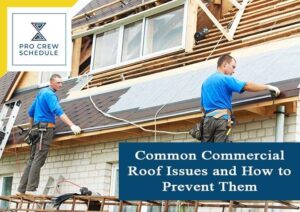Having any structural issue can be a hassle to fix, especially when said structure is either complicated, has significant size and height, or both. As much as one wants to avoid construction defects and the need to repair them, they are more often than not inevitable and can, unfortunately, happen on all kinds of buildings, regardless of age or size.
But while other issues, such as cosmetic wall cracks or broken floor tiles, are easier to solve, for the most part, roof issues are not as simple. Roof issues often signal the start of having what seems like pretty straightforward fixes, only to come out as very tricky eventually, and sometimes, very dangerous and risky.
Managing construction projects that involve commercial roof fixes can be a challenge. Still, it’s possible to be done correctly if the issues are appropriately identified and the appropriate solutions to fix, or even better, prevent them in the first place, are employed. It may take some effort, but the result and long-term benefits make all the work worth it.
Here are some of the most common commercial roof issues and how to prevent or fix them.
Water Pooling/Ponding
Water pooling is perhaps the most common problem one will encounter when it comes to roofs. This is often a concern when it comes to commercial buildings with flat roofs, something that is solved by having slightly tapered areas over the surface to allow the water to run off.
However, issues from the very beginning like poor proper management for construction can lead to the taper being insufficient, or in the worst cases, non-existent at all. It is important to prevent water pooling as this can lead to a chain reaction of roof problems that will eventually cascade into other issues for the rest of the structure.
Symptoms of Water Pooling:
The primary symptom of water pooling is, as the name implies, water is pooling after rain or snow. If there are numerous spots where water is pooling upon inspection, whereas other areas have dried out, then this should be fixed immediately.
Preventive Measures:
Proper construction crew management can ensure that if the structure has a flat roof, then the tapered areas necessary to avoid water pooling are implemented in the first place. If water pooling is already occurring, roof leveling solutions should be put into effect to prevent further pooling or ponding.
Should this problem not be fixed, and pooling continues to happen and it can lead to:
Roof Leaks
Roof leaks are perhaps the most common and most ubiquitous problem for residential and commercial roofs. Whether it’s a small commercial building for small hole-in-the-wall businesses or colossal ones like an indoor sports stadium, roof leaks can cause significant problems if left untreated.
Water leakage from roofs can do all sorts of damage, from seeping into concrete, especially in old buildings, which can severely affect the steel reinforcement of the structure, to dripping onto the ceiling and eventually coming into contact with appliances and other electrical devices found below.
As mentioned, water pooling or ponding can eventually result in roof leaks as the roofing material erodes over time. But what makes it quite difficult to fix is that there can be many causes of roof leaks, not just water pooling, a simple crack on the roof, or a slight hole undetected somewhere. Roof leaks can be caused by all sorts of issues, which is why it is essential to fix the issues that are known to cause a roof leak, narrowing down the list of other possible sources of the leakage.
Symptoms of Roof Leaks:
The most apparent symptom of roof leaks is, of course, dripping water from the roof or in structures with ceilings or from the top itself. Roof leaks can often be found in high-risk areas such as near skylights, around gutters, flashing points, or near chimneys and ventilation outlets, but can occur anywhere on the roof.
Preventive Measures/Solutions:
Preventing the problem, or at the very least prolonging its onset, can be done right at the beginning while work is being done in the construction site. How? By using top-quality materials and proper construction methodologies when installing the roof in the first place. Ensuring that correct and long-lasting materials are used with the appropriate construction techniques and that the roof is appropriately inspected to give quality assurance to the customer and stakeholders, roof leaks can be delayed, if not outrightly prevented.
Proper regular maintenance of the roof is also crucial. Scheduled inspections to look for possible sources of leaks can ensure that a small issue does not grow into a full-blown problem, one that can cost a lot of time and money to fix.
Once a leak occurs, even in small drips, it is essential to detect the source immediately. Since the said inspection is crucial, it should be conducted as soon as possible to do, and if and when the source of the leak is found, it is essential to address it immediately.
But as we mentioned earlier, roof leaks don’t always come from roofs themselves. If an inspection of the roof doesn’t result in the source of the leak, then it can probably mean one of all of the following:
Clogged Drains and Gutters
A building’s roof might be clear of possible cracks and leaks and leveled properly to avoid pooling, but if the water has nowhere to go because of clogged drains and gutters, then the problem just moved from one place to another.
What makes clogged drains and gutters challenging to spot initially is the fact that unless adequately inspected, it can be hard to realize that the problem is the gutter or the drain in the first place. Clogged drains and gutters can cause signs and symptoms similar to roof leaks, which could point workers or inspectors to the roofs, only to find nothing.
Conversely, possible roof leaks or roof water pooling could be discovered and addressed, only to find out that the leaks don’t stop because the inspector neglected to check the gutters and drains.
Clogged drains and gutters can cause water to back up and spill over to the roof or other parts of the structure. Over time, it can cause the gutters and drains themselves to get damaged, causing the water to go to unexpected places, such as eaves, which can cause materials to rot.
Symptoms of Clogged Drains and Gutters:
As mentioned earlier, it can be challenging to spot this because it is very similar to leaking roofs. However, a clogged gutter will usually cause spillages, especially during heavy rains where there shouldn’t be any, so if this occurs, then it is time to have the gutters inspected. Similarly, if drains are not diverting enough water compared to what the roof is receiving, or even worse, not have flowing water at all, then the drain is clogged and should be fixed.
Preventive Measures and Solution:
Regular maintenance is necessary to avoid having clogged gutters and drains. For example, both gutters and drains should be checked for blockages, especially during seasons where a high amount of leaves, twigs, and other debris are expected. Having screens on gutter openings can also help prevent the debris from clogging up the gutter and the drains.
Should the drains and gutters get clogged, it is essential to have them professionally cleared immediately as soon as the weather allows it.
It is crucial to have all of these issues prevented or resolved immediately because it can lead to an even bigger problem if they are not.
Damaged Roofing Materials
This is perhaps the costliest of all the problems that can occur on a roof. Inevitably, the materials used for the roof will eventually have some damage, from small punctures and holes to cracking and more. However, not addressing the three roofing issues mentioned earlier can exacerbate this problem, which can cost the building owner lots of time and money.
The worst part is that this can occur not just from leaky roofs or water pooling, or blocked drains. Snow and ice can cause roof damage and such damages can be considered inevitable for commercial buildings that experience snow. Roofs equipped with synthetic rubber membranes like EPDM can experience shrinkages, which can also cause in itself other problems.
Symptoms of Damaged Roof Materials:
Leaks occurring beneath the roof are a possible symptom of damaged roof materials. Still, perhaps the most common way to know is by visibly inspecting the roof itself for physical and other damages.
Preventive Measures and Solution:
Proper installation, one done with the best methods possible, coupled with the best materials available, can delay the roof from getting damaged too early in its life cycle. Spending a little more money, such as installing screens for the drains, can go a long way in preserving the roof materials’ integrity and preventing further damage.







